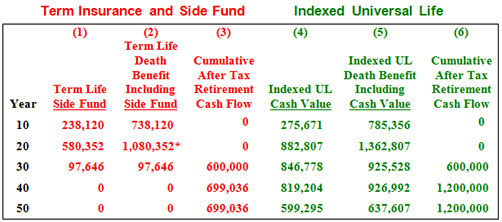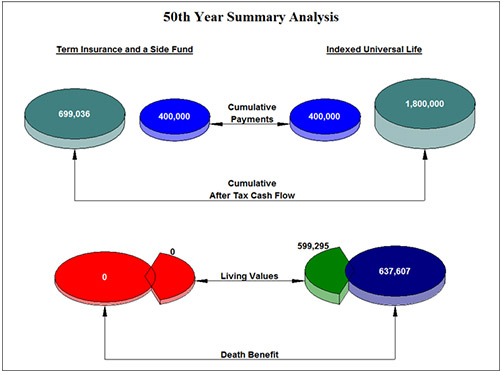Suppose someone says to you:
- "Cash value life insurance is a rip-off only a financial idiot would buy."
- Or "It’s better to buy term insurance and invest the difference."
- Or "Why would you spend thousands for something you could get for a few hundred?"
- Or maybe you run into Suze Orman who says repeatedly:

?I HATE WHOLE LIFE INSURANCE?
?I HATE UNIVERSAL LIFE INSURANCE?
?I HATE VARIABLE LIFE INSURANCE?
?THE ONLY TYPE I LIKE IS TERM INSURANCE.?
There is no valid economic theory that explains why a bad idea is acceptable simply because one hears it frequently.
So ? consider asking this question of those who think like Suze Orman: If something important you believe to be true turns out to be wrong, when would you want to know about it?
How about . . . now?
Case Study
George Baker is age 45 and is in a 40% marginal tax bracket. He plans to purchase $500,000 indexed universal life with scheduled premiums of $20,000 a year for the first 20 years; $0 thereafter. Cash values are illustrated growing at 7.5%, and the policy is intended to provide:
1) Protection for his family;
2) After tax cash flow of $60,000 a year from age 65 to 95 (withdrawals to basis; loans thereafter).
One of George’s advisers asks, "Why would you spend $20,000 when you could get term insurance for $600?"
If that's all there is to it, he shouldn’t. But has anyone ever bothered to show you mathematically why term insurance is always a preferred choice? Or if you ask, do you get something like, "Duh . . . isn’t it obvious?"
Actually, it’s not obvious at all. American humorist Josh Billings once said that "It ain’t ignorance causes so much trouble; it’s folks knowing so much that ain’t so.?
We compared George’s indexed universal life to $500,000 of 20-year term insurance at $600 a year. The term insurance alternative assumes a side fund yielding 7.50% on $19,400 a year, the difference between the $20,000 premium for the indexed universal life and the $600 premium for the term. We included a management fee of 0.75% for the side fund.
In order to match the term and side fund with the $60,000 cash flow from the indexed universal life policy from age 65 to 95, the side fund has to deliver the same $60,000, and it doesn’t come close to doing so.
See the differences in values below.

*Year 20 is the last year of the term life coverage. Thereafter, there is the side fund only, and it is depleted in year 32.
The cash value of the indexed universal life (Col. 4) outperforms the side fund (Col. 1) by a considerable margin. In addition, the death benefit of the indexed universal life (Col. 5) remains in force long after the term insurance expires (Col. 2). All this occurs with no premiums required by George during his retirement years.

Click here to review the comparison illustration in detail.
Conclusion
If cash flow is in short supply or if the need for coverage is for a brief period, term insurance can make a lot of sense; however, for longer intervals, if the cash flow exists to buy what you want, a cash value policy is the only logical choice.
If you are licensed for the InsMark Illustration System and would like to review the menu prompts we used for this analysis, please email us at bob@www.robert-b-ritter-jr.com, and we will get the Case Data file (Workbook) right out to you.
For a license to use the InsMark Illustration System, go to IIS or contact Julie Nayeri at InsMark at julien@insmark.com or 888-InsMark (467-6275). Institutional inquiries should be made to David A. Grant, Senior Vice President ? Sales at dag@insmark.com or (925) 543-0513.